Steric hindrance - Study guides, Class notes & Summaries
Looking for the best study guides, study notes and summaries about Steric hindrance? On this page you'll find 63 study documents about Steric hindrance.
Page 2 out of 63 results
Sort by
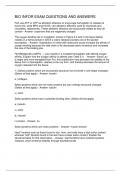
-
BIO INFOR EXAM QUESTIONS AND ANSWERS
- Exam (elaborations) • 7 pages • 2023
-
- $10.99
- + learn more
Fish use ATP or GTP as allosteric effectors to encourage hemoglobin to release its bound O2, while BPG and HCO3‒ are allosteric effectors used by mammals and crocodiles, respectively. These allosteric effectors are structurally related as they all contain - Answer- oxyanions that are negatively charged The oxygen binding site in myoglobin, shown in Figure 5.2 and in the figure below, resides in a heme pocket in which a valine residue provides one of the pocket boundaries. - Answer- Substitu...
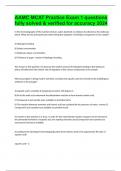
-
AAMC MCAT Practice Exam 1 questions fully solved & verified for accuracy 2024
- Exam (elaborations) • 80 pages • 2024
- Available in package deal
-
- $15.99
- + learn more
In the chromatography of the reaction mixture, water absorbed on cellulose functioned as the stationary phase. What was the principal factor determining the migration of individual components in the sample? A) Hydrogen bonding B) Solute concentration C) Stationary phase concentration D) Thickness of paper A) Hydrogen bonding The answer to this question is A because the relative amount of hydrogen bonding to the stationary phase will determine the relative rate of migration of the vario...
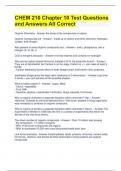
-
CHEM 210 Chapter 10 Test Questions and Answers All Correct
- Exam (elaborations) • 4 pages • 2024
-
Available in package deal
-
- $12.99
- + learn more
CHEM 210 Chapter 10 Test Questions and Answers All Correct Organic Chemistry - Answer-the study of the compounds of carbon Organic Compounds are - Answer-- made up of carbon and other elements: hydrogen, oxygen, and nitrogen Also present in some organic compounds are: - Answer-- sulfur, phosphorus, and a halogen (F, Cl, Br, I) CO2 is inorganic because: - Answer-it is less reactive and contains no hydrogen Why are we carbon based life-forms, instead of Si or Ge based life forms? - An...
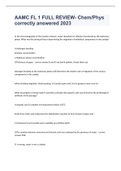
-
AAMC FL 1 FULL REVIEW- Chem/Phys correctly answered 2023
- Exam (elaborations) • 24 pages • 2023
- Available in package deal
-
- $19.99
- + learn more
AAMC FL 1 FULL REVIEW- Chem/Phys correctly answered 2023In the chromatography of the reaction mixture, water absorbed on cellulose functioned as the stationary phase. What was the principal factor determining the migration of individual components in the sample? A.Hydrogen bonding B.Solute concentration C.Stationary phase concentration D.Thickness of paper - correct answer B and D are dumb options. Knock them out. hydrogen bonding to the stationary phase will determine the relative rat...
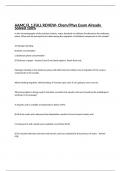
-
AAMC FL 1 FULL REVIEW- Chem/Phys Exam Already Solved 100%
- Exam (elaborations) • 25 pages • 2023
-
- $15.99
- + learn more
In the chromatography of the reaction mixture, water absorbed on cellulose functioned as the stationary phase. What was the principal factor determining the migration of individual components in the sample? A.Hydrogen bonding B.Solute concentration C.Stationary phase concentration D.Thickness of paper - Answer B and D are dumb options. Knock them out. hydrogen bonding to the stationary phase will determine the relative rate of migration of the various components in the sample. When...
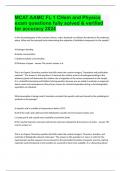
-
MCAT AAMC FL 1 CHem and Physics exam questions fully solved & verified for accuracy 2024
- Exam (elaborations) • 25 pages • 2024
- Available in package deal
-
- $16.49
- + learn more
In the chromatography of the reaction mixture, water absorbed on cellulose functioned as the stationary phase. What was the principal factor determining the migration of individual components in the sample? A.Hydrogen bonding B.Solute concentration C.Stationary phase concentration D.Thickness of paper The correct answer is A. This is an Organic Chemistry question that falls under the content category "Separation and purification methods." The answer to this question is A because the ...
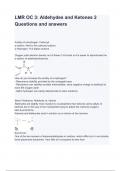
-
LMR OC 3: Aldehydes and Ketones 2 Questions and answers
- Exam (elaborations) • 3 pages • 2024
-
Available in package deal
-
- $7.99
- + learn more
Acidity of α-Hydrogen: Carbonyl α-carbon: Next to the carbonyl carbon. α-Hydrogen: H of alpha carbons Oxygen pulls electron density out of these C-H bonds so it's easier to deprotonate the α-carbon of aldehydes/ketones. How do you increase the acidity of α-Hydrogen? - Resonance stability provided by the conjugate base - Resonance can stabilize enolate intermediate, since negative charge is distributd to more EN oxygen atom - Alpha hydrogen can easily deprotonate in basic solutions...
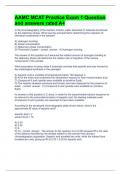
-
AAMC MCAT Practice Exam 1 Question and answers rated A+
- Exam (elaborations) • 62 pages • 2023
-
Available in package deal
-
- $17.49
- + learn more
AAMC MCAT Practice Exam 1 Question and answers rated A+In the chromatography of the reaction mixture, water absorbed on cellulose functioned as the stationary phase. What was the principal factor determining the migration of individual components in the sample? A) Hydrogen bonding B) Solute concentration C) Stationary phase concentration D) Thickness of paper A) Hydrogen bonding The answer to this question is A because the relative amount of hydrogen bonding to the stationary phase wil...
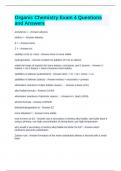
-
Organic Chemistry Exam 4 Questions and Answers
- Exam (elaborations) • 5 pages • 2024
-
Available in package deal
-
- $10.49
- + learn more
acetylenes = - Answer-alkynes olefins = - Answer-alkenes E = - Answer-trans Z = - Answer-cis stability of cis vs. trans - Answer-trans is more stable hydrogenation - Answer-exothermic addition of H to an alkene relate the heats of reaction for trans-butene, cis-butene, and 1-butene. - Answer-1-butene > cis-2-butene > trans-2-butene (most stable) stabilities of alkenes (substitution) - Answer-tetra- > tri- > di-> mono- > un- stabilities of alkenes (status...

-
Chem 471 Exam 2 Material (ALL SOLVED)
- Exam (elaborations) • 10 pages • 2023
- Available in package deal
-
- $11.49
- + learn more
Nucleoside vs. tide correct answers nucleoside: no phosphate group tide: A vs. B form of helix correct answers (both right handed) B: -predominant form in aq. -B can accommodate a spine of water molecules lying in the minor groove (not A): H bonding between h2o and DNA contributes to stability of B form -slightly tilted A: -RNA = always A b/c of steric hindrance in B w/ extra hydroxyl group -grooves are nearly equal -Bases lie farther to the outside and are strongly tilted with r...

$6.50 for your textbook summary multiplied by 100 fellow students... Do the math: that's a lot of money! Don't be a thief of your own wallet and start uploading yours now. Discover all about earning on Stuvia


